Hours: Thurs-Mon, noon-6 pm

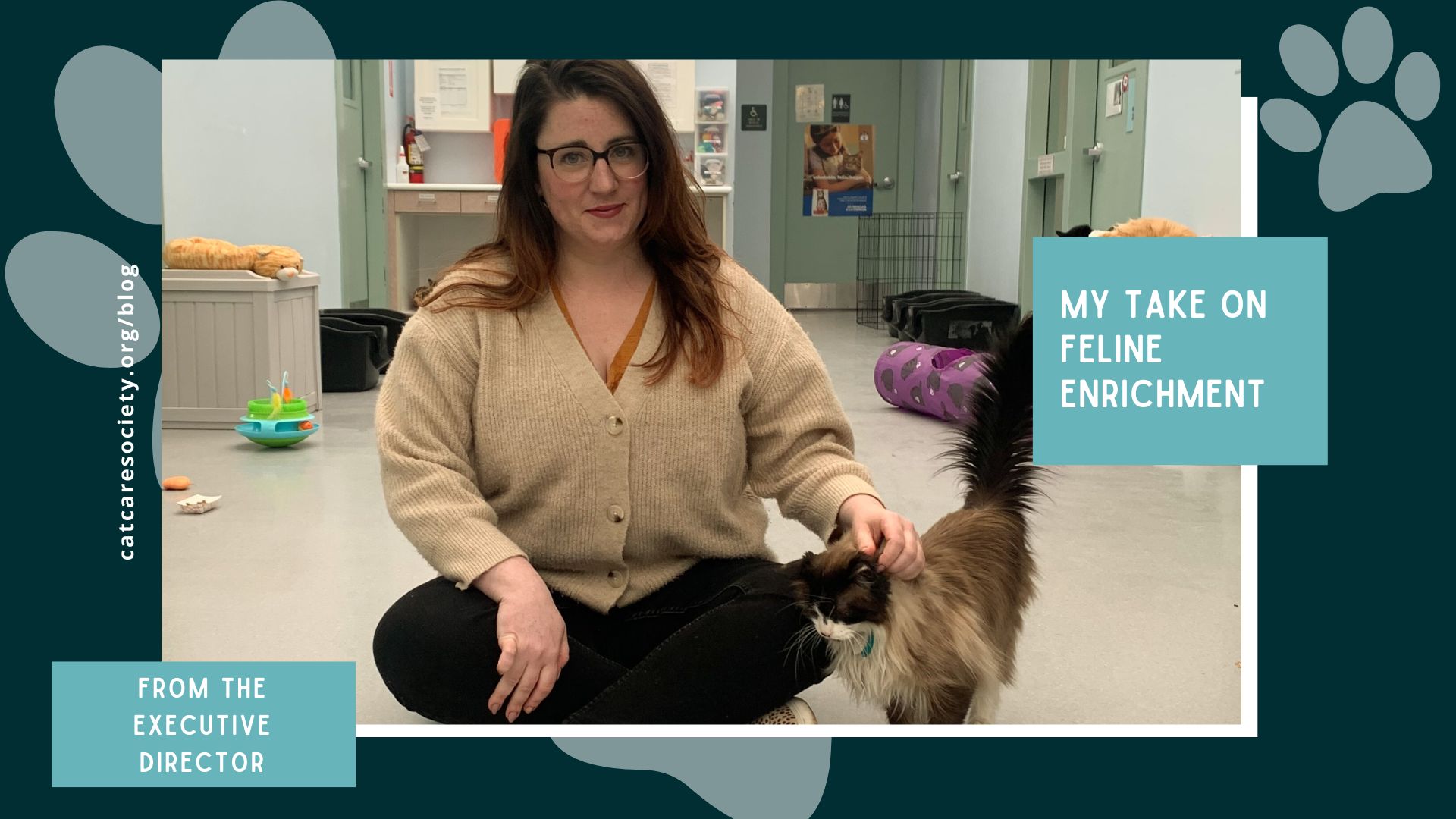

Abandoned, neglected and wounded after surviving a house fire, Fish Stick was found by a kind neighbor just in the nick of time. Little did anyone know, he was already up against more struggles than met the eye.
Believed to be the only surviving pet, this senior Siamese mix was down to 6 pounds and in dire need of medical attention. Realizing the level of care he needed, the neighbor reached out to our friends at Cooper’s Companions Animal Rescue for help. They brought him to Cat Care Society, knowing our specialty in helping cats that others would give up on.
Fish Stick had severe lesions on his face, neck, back and paw pads. He immediately received antibiotics, fluids and pain medication. He needed a cone to stop scratching at the sites.
Without veterinary treatment for so long, Fish Stick’s wounds were infected and bleeding.
“His teeth were horrific, his skin was falling off, and he was just a complete mess,” our lead veterinarian Dr. Cecily Palamara, recalled.
Further exams revealed he also had a heart murmur, severe periodontal disease, conjunctivitis, upper respiratory infection, anemia and about 8 more underlying conditions. Not to mention a positive ringworm test. Add to that, he was blind in one eye from a previous trauma. We called it his wizard eye.
Considering his multitude of issues, a successful long-term outcome was unclear. Our goal shifted to maintain his quality of life while treating what we could.
From the start, Fish Stick was a total lovebug. Regardless of any pain he felt, he maintained the sweetest disposition, purring constantly and rubbing affectionately on staff during every treatment. It seemed he was up for the fight.

After addressing his most urgent needs, we slowly started ticking concerns off the list. Within a couple weeks, we saw significant improvement. He was gaining weight, hydrated again, his conjunctivitis was resolved, and his skin was looking better. Test results showed that some of his skin issues were not burn related, but were actually allergies. A month in, his liver values were completely resolved, anemia was on the right track, but his lymphocytosis was worsened.
Just when he took one step forward, there were another two steps back.
One employee stepped up to foster Fish Stick for close monitoring and an aggressive medication regimen.
After numerous medical setbacks, Fish Stick turned the corner in his foster home.
In foster, Fish Stick began to thrive. Just weeks in, he was markedly improved on nearly all accounts and finally clear of ringworm. His fur grew back in and he was at an ideal weight.
“He kind of became a celebrity,” Dr. Palamara recalled. “The whole team would come down for his rechecks. Every time we saw him, he looked better and better. He just needed some time and TLC, and he got that here.”
About 100 days after he came through our doors, Fish Stick was ready to become a candidate for adoption — with no less than 14 medical disclaimers. To make sure his adopter knew the extent of his conditions, a consult with our vet was required.
A host of medical issues was no concern for his adopter ready to open his heart and home.
Michael came to the shelter looking for a Siamese cat after losing his own. He learned about Fish Stick’s history and ongoing concerns but was unfazed, willing to take on whatever came with this friendly boy.
After going home with Michael, Fish Stick settled right in. He even gained a new friend, as Michael adopted another CCS cat, Jack, from us the same day.

“Every day, both cats are getting more comfortable, and I’ve spent a lot of time playing with them,” Michael updated. “Jack is renamed Taz after the Tasmanian devil since he runs around like a tornado. Both cats are super smart and such a joy.”
Looking at him now, you’d never suspect Fish Stick made it through such a horrific event. The time and energy we put into this cat was significant, and his glow-up is a perfect example of who we are and what we do best. All in all, the cost of Fish Stick’s medical care alone was near $3,000. This does not include everyday expenses of living in a shelter, such as his food, litter, supplies or staff time.
Fish Stick pioneers a way for so many other cats who deserve a second chance after a bleak outlook.
We simply wouldn’t be able to take care of cats like Fish Stick if it weren’t for your support. Your tax-deductible donation ensures that more cats facing the worst have a chance at finding health and happiness in a new loving home.
With hope and gratitude,
EC Michaels
Executive Director
Cat Care Society
P.S. Thanks to you, Cat Care Society was able to help over 1,000 cats last year! Because we rely 100% on donations to keep up, we need your help to find loving homes for cats in need.
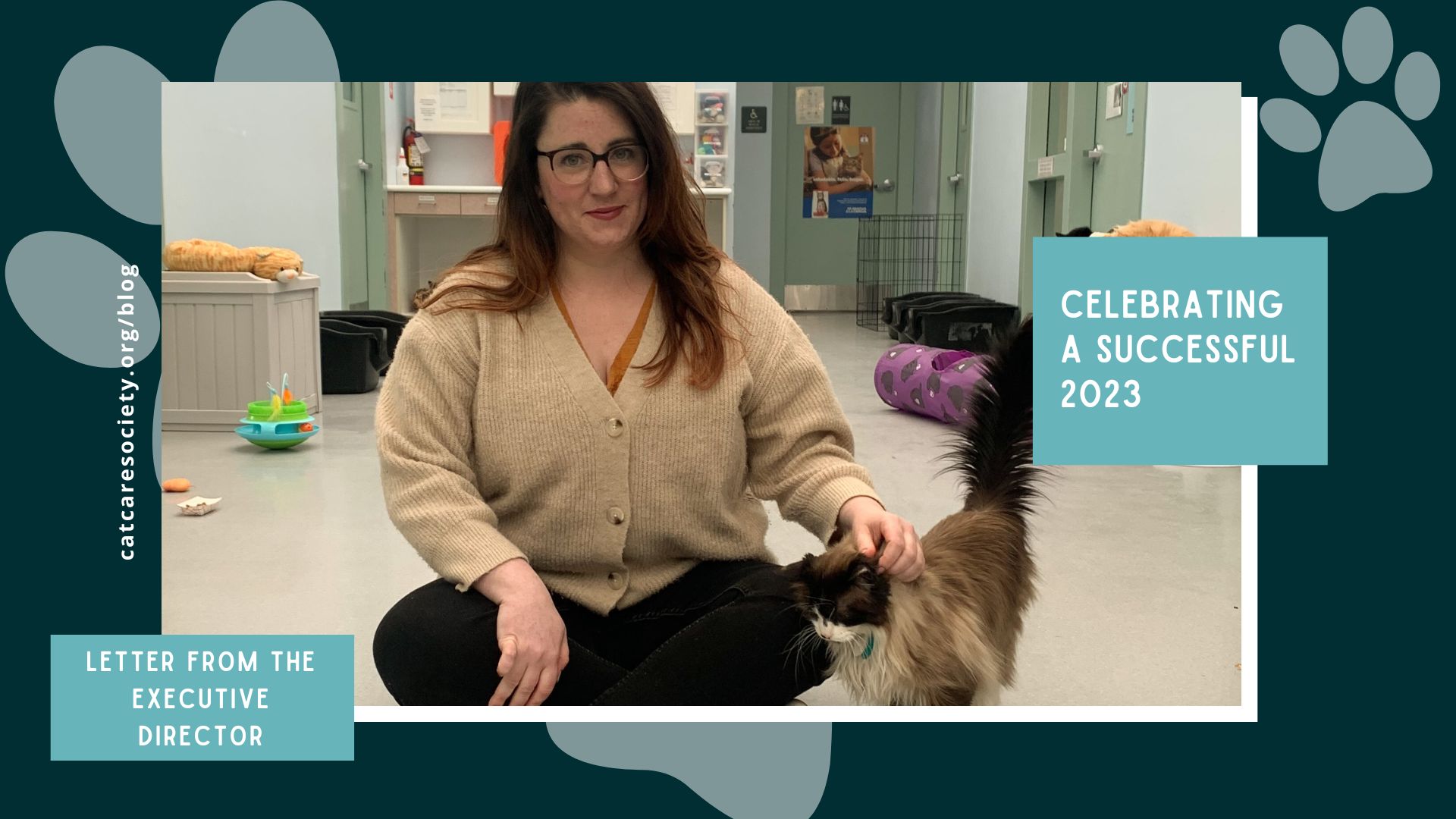
Now that 2023 is in our rearview, I am so humbled and excited to share our calendar-year stats and successes with you all. It was a busy year, with numbers up across the board. Even though we saw more cats in need than ever before, we also adopted more cats than ever before. Last year, over 1,000 cats were placed into loving homes thanks to your support!
In comparison, in 2022, Cat Care Society took in 860 cats and adopted out 750 of them.
Across the country, many shelters faced an increase in animals in need and owner surrenders. Economic conditions, inflation, lack of veterinary care and access, and the veterinary shortage, all affected the tough year that many shelters, rescues and animal welfare organizations faced.
I think it’s important to acknowledge that our statistics do not reflect the larger trend in animal welfare. It’s likely our specialty that makes us an anomaly. Because we care for so many special needs cats, our status as a limited-admission shelter, and our policies and partnerships, we recognize how special it was to help more cats find homes than we’ve ever been able to before. We also want to give a nod to the other shelters in our region, who work just as hard as we do to save and adopt as many pets as possible. We were happy to support their work by increasing the number of transfers we took in from our local shelter partners.
Over the last year or so, we’ve shifted how we think about taking in new cats. It’s easy to focus on the numbers above, but it’s just as important to think about the why behind them. For us, it’s all about balance for the entire shelter ecosystem.
This balance has helped us increase our support of special needs cats — as demonstrated by having over 100 diagnosable conditions we treat and place for — but we also know that CCS is more than that. No matter our niche, we will always support all cats in need. That includes young and healthy cats. Or cats who simply haven’t found a home in another shelter.
We’re proud to be members of the Metro Denver Animal Welfare Alliance (MDAWA) and work with many other organizations in the region to transfer cats in so they have a new opportunity here. We also aim to offer education for adopters on how to care for their cats.
Through it all, we balance our cat population against our resources; our staff size and budget must support our ability to care for the cats in our shelter. We’re constantly evaluating how we can grow proportionately. This is, after all, also aligned with our new strategic plan and CCS’ mission.
This level of control is one of the benefits of being a limited-admission shelter. By contrast, open-admission shelters are required to take in any animal that comes through their doors. If they happen to have an influx of complex medical cases (which require more time, money and expertise) at one time, they do not have the same options we do. It requires creative solutions — as well as some strain — on how they make it work.
Having worked in both types of shelters, I am so grateful for the unique community that Cat Care Society has. In my time here, I’ve challenged the team to be thoughtful and strategic in everything we do. Remaining a safe place for cats who need help, and finding them loving homes, is always our top priority.
I am more energized than ever to see what the rest of this year brings. As always, thank you for your support!
EC Michaels
Executive Director
Cat Care Society

Sometimes in our line of work, we think we’ve seen it all. Routinely taking in special needs animals and complicated medical cases brings the sense of rarely being surprised or shocked. But every now and then, reality gives us a little kick in the form of a cat like Kurt.
Kurt’s (formerly Gray-Cin) previous owner recognized that he needed more medical care than she could give, and chose to surrender him to Cat Care Society last year. To say he was in rough shape would be an understatement. At only 3 years old, the extent of his condition left our medical team in awe.
Kurt, named after the famed Nirvana frontman, was in so much pain that he lashed out during his initial exam. He had to be put under anesthesia just so we could assess him and get to work.
His wounds were seeping, his tissues were severely diseased, and his eyes and sinuses were in extreme danger.
Add to that, his fur was severely matted, but a full-body shave is an easy fix compared to the time and care the open wounds on his face would need. Turns out, Kurt had a tooth abscess that had been neglected so long that it ruptured, spread to his nasal cavity, caused a severe infection and resulted in a visible, fluid-filled cavity in his cheek. His case was marked a priority, and our medical team quickly got to work.

This alone could have been fatal, but there was more to come.
One of his teeth fell out when we first looked in his mouth, and it was clear that many more needed to be extracted before this gorgeous gray guy was going to feel the pain begin to subside.
He struggled to eat. His face was so swollen that it was difficult to see his right eye, and he was at risk of permanent damage without quick intervention.
Our lead vet, Dr. Cecily Palamara, said it was one of the most severe cases of sinusitis she had ever seen.
Kurt received X-rays, antibiotics and pain medication, and had his wounds flushed. He needed multiple surgeries to fully treat the wound and remove infected teeth and bone.
When he woke up from his first surgery, the relief in his eyes was immediate. The worst of his pain was finally gone. After a few days, he was talkative and asking for attention. After a few weeks, the swelling subsided. The abscess was almost completely resolved.
The result? Kurt became a gentle, happy lad who liked to play and be around other cats and people.
Once he was fully healed and up for adoption, it only took a week to find his new family.
Marc and his teenage son visited the shelter looking for a middle-aged cat who would do well with their dog, Bear. Kurt caught their eye thanks to his polydactyl feet and snaggletooth.
“He was bedraggled; I could tell he was in a rough spot but just needed some support,” the high schooler recalled.

Kurt adjusted pretty quickly to his new home, becoming a confident and independent explorer, and never losing the loving nature he showed from the moment he started to feel better.
“He has been the sweetest boy since we got him,” Marc’s son said. “As he came out of his shell, he started to play and make biscuits. He always talks to us, asking to be pet or be fed. He’s the biggest cuddler ever!”
Due to the extent of his injuries, Kurt’s sinuses and tear ducts will never quite be the same, though he is comfortable again. Kurt’s family reports that he still sneezes and has a runny nose occasionally, but his beautiful coat has grown back in and you’d never know what he went through.
Kurt is now a very sassy cat who knows how to meow till he gets what he wants. He struts around his home, loves catnip mice, and relishes in chin and belly rubs.
Kurt’s case is an extreme example of the importance of cats’ dental health. Because dental disease is so prevalent, tooth root abscesses are common but can be prevented with good oral hygiene and regular vet visits.
It was 317 days between when we first met Kurt and when he went to live with Marc and his family. That’s dedication and care, and it’s what we do best.
Even though Kurt’s case is a unique one, his story is just one of countless cats who receive top-notch medical care above and beyond what many other shelters would be willing to take on. It’s a testament to the spirit of Cat Care Society’s approach in caring for all cats and the dedication of our team.
We thank each and every one of you for your support in continuing to help cats in need.
With gratitude,
EC Michaels
Executive Director
Cat Care Society
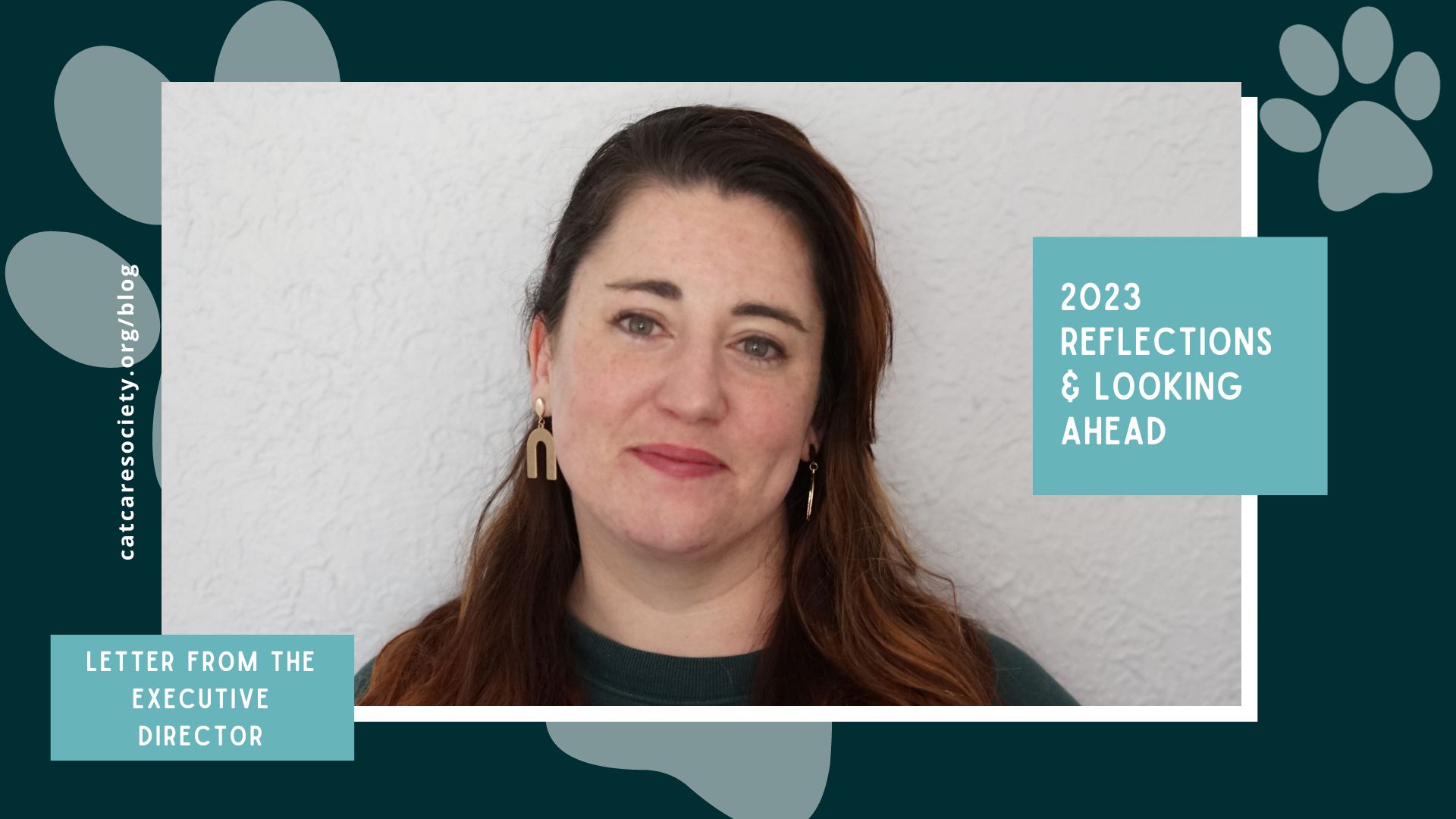
As we begin to put a wrap on 2023, I reflect with so many emotions on this past year. My first full year as executive director of this dynamic organization has come with many highs and, as unfortunately happens in so many shelters, a few lows. But above all else, I am struck by overwhelming gratitude.
Not only have we been able to increase our reach, expand partnerships and bring on talented new team members, but we’ve helped more cats than ever before. Our length of stay (how long a cat, on average, is in our care before adoption) has decreased to 41 days — which is pretty incredible considering we increased our intakes and transfers and consistently welcome many special needs cats who others would deem hard to adopt.
For every animal we saved through groundbreaking medical care, new enrichment and socialization techniques and adaptive community services and programs, I am more filled with hope than ever. This summer’s launch of our new strategic plan and organizational identity set forth a strong map forward as Cat Care Society continues to evolve to meet the needs of our cats and our community. We are already beginning to see the earliest fruits of these labors, as we strengthen our commitment to our staff, systems, volunteers, visibility, and our future.
With more focus on developing our emerging leaders and staff members, we’ve been able to send CCS faces out into the community to network with their peers, learn from other organizations and fine-tune their knowledge and skills for each of their unique roles. I am so grateful to industry organizations like the Association of Animal Welfare Advancement, ConnectingColorado, Animal Welfare Association of Colorado, Metro Denver Animal Welfare Alliance, West Metro Chamber of Commerce and other shelter and community partners that keep us connected to trends, tips and information as we continually seek to do better.
Soon you will see further details on the impact of our work for our last fiscal year (stay tuned for our annual report coming out in early January!). For every statistic and data point, there is a cat with a story. It does not land lightly on us that the impact we have on cats’ lives is literally life-changing. I’m so proud that we’ve been able to help more cats than ever before, with over 1,100 cats coming through our shelter in the past year. While I wish we could tell the story of each and every one of them, I hope you find some time to read the stories of some of our longest-staying or hardest-to-adopt cats, which you can find on our website under Success Stories. Even just putting together 10 of our most impactful cases moved me deeply. It would be such an understatement to say that I am blown away by the dedication, kindness, compassion and work that our team puts into the lives in our hands. Time after time, CCS staff members have shown that we don’t give up. The amount of time, effort, money and resources that we put into our cats, is truly something special and paints just a small picture of what it’s like to work in this field. I will never be able to thank my team enough for the work that they do.
CCS is and always will be an organization that is committed to the goal of finding cats loving homes. However, we will never rush this process and have put steps in place to ensure that each cat is truly ready. We are focused on providing the best medical care and support for each animal that comes through our doors by understanding his or her unique medical and/or behavioral needs. We consistently ask what a cat needs to live its best life and offer transparent information to potential adopters about what to expect and support that animal. We don’t just diagnose conditions; we go a step further to dig into the root cause of what a cat needs to truly thrive for his or her future.
The fact that we always go the extra mile is one the things that makes CCS so special. Just one example is a cat named Amaryllis, a stunning 8-year-old lovebug who arrived in April. Amaryllis came to CCS as a medical transfer, underweight with a heart murmur, alopecia and in need of a dental. At first, she seemed to be in decent shape, considering, but then we noticed something else. After a few days, a medical recheck found a distended abdomen and fluids around her reproductive parts. After a full exploration, we found lingering issues from an old surgery and treated it. Because we took these extra steps, we found something that easily could have been missed and are confident her outlook is now even more positive.
I realize that the CCS many of you have known and loved for years is beginning to look a little bit different. I want to assure you that every change that has been implemented has been done with much discussion, care and concern for the cats and people we’ve served throughout our rich history. In fact, I don’t see it as change as much as it is adapting. The pandemic turned the world on its head and shifted many ways of thinking. In our world, trends continue to shift and new research offers new opportunities. To survive in this day and age, we must be agile and know when to pivot. I am forever grateful to every single staff member, volunteer, donor and partner who has stuck by our side as Cat Care Society evolves and grows. We are building on our rich 40-plus year history and setting the foundation for so many more good things to come. We are investing in our people and our metro community. This solidified identity and mission ultimately allows us to help more cats!
Our most recent Clear the Shelters event proved that our region is ready to do this, and we have a community willing to say yes to the tougher cases. We celebrated our most adoptions in a single day, ever last August! I am also filled with gratitude for the overwhelming response once again to our Colorado Gives Day fundraising campaign. We exceeded our fundraising goal, raising just over $152,000 for the shelter cats. We are overwhelmed by your generous support and endlessly grateful. Now, we are more invigorated than ever to bring this energy to the larger community.

Of course with rising costs of our own and more cats in need than ever, we need your continued support. As we look ahead, we hope to purchase another surgical table specifically for dentals. One of the biggest bottlenecks of sheltering in general is dentals, and because CCS takes in so many older cats, our medical wait list is often what prevents us from helping more cats due to the resources we have. Even one more table in our surgical suite would mean hundreds more cats getting earlier dental treatment than before. We are also building plans to enhance our feline behavior & enrichment program and look to purchase more supplies to support caring for cats that need a little more time and attention.
As CCS continues its forward motion in a changing landscape, we are as dedicated as ever to our core values, positively transforming our staff, systems, people, processes and visibility for a bright future, as guided by our strategic plan. To ensure this long-term success, we will remain adaptable and invested in the well-being of our cats, our people, our facility, our partnerships and our community. As we navigate rising costs and increased need, we’re also opening our doors to more partners across the state, bringing in more animals and broadening our outreach. Our team is excited about continuing to build a beautiful foundation based on trust, transparency and the most loving care for cats in our region. We will continue learning, growing and striving to be a place where no cat is left behind. Your support can make this possible!
Your philanthropy allows us the power to change the lives of not only the cats that we take in and care for, but the lives of their future adopters. It is what enables Cat Care Society to go the extra step for each and every cat that comes through our doors.
We hope we can count on you as an ambassador to this work as we think critically about our future. The world of cats is ever changing, and we’ve demonstrated we can be successful while also keeping CCS’ values and identity at the heart of our every day. As we celebrate this special community and each cat who finds a home, I invite you to join us.
We believe in transparency and always want to be available for questions or clarifications around our statistics, policies or procedures, and ask that you simply reach out if you hear any information about us and want to ensure its validity. Email executivedirector@catcaresociety.org to set up a time to talk.
Thank you, and cheers to a happy and healthy New Year filled with feline friends.
Warmest regards,
EC Michaels
Executive Director
Cat Care Society

Probably one of our shelter’s biggest transformation stories comes in the form of two bonded orange tabbies named Garfield and Big Red. Both came to us as ferals from other shelters within days of each other in January 2023, and both brought with them an FIV+ diagnosis.
Big Red (the one with the white blaze on his chest) arrived from Nebraska as an overweight stray. He appeared mostly healthy, friendly but timid and easily overstimulated. In his first exam with our medical team, he leaned into pets but was not overly comfortable being handled. We spotted some mild gingivitis and dental disease, but were unable to obtain a blood panel. Big Red became so stressed out from the experience that he became aggressive and fearful. We decided to forego his dental procedure and inform his future adopter to discuss treatment with a private vet.
At the end of Big Red’s first week, he was still fearful, hiding in his room on a shelf behind blankets. But after a few minutes of us in the room, he would visibly relax and allow pets on his cheek. He startled easily, so we moved slow around him. Within a few more days, shelter visitors told us that Big Red was allowing them to pet him extensively and was even rolling over to show his belly!
A few days before Big Red entered into CCS’ care, his soon-to-be-buddy Garfield arrived from another Colorado shelter after bouncing around other rescues in the Midwest. And he proved harder to handle.
From the start, our team was unable to touch Garfield. He lunged, was fractious and needed sedation just to be examined. We found that he had a corneal ulcer in one eye, periodontal disease and ruptured abscesses from a recent neuter. We were concerned about how to care for him and considered finding him a foster in the hopes he would be calmer in a home setting.
In the meantime, Garfield was moved into our FIV+ room, and we hoped he’d get along with other cats. The first day was promising; he laid next to others without issue, and we watched him closely while he acclimated. But by Valentine’s Day, there was no love in the room as our team found evidence of fights between Garfield and Gordon. He was also consistently swatting and hissing at staff who tried to offer him some attention. It was clear he was in distress.
Days later, he needed another exam to check his scrotal abscess, he again refused to be handled and needed sedation. The good news is his wounds had healed, but we were worried about not being able to medicate him. We reached out to his prior shelters for more information and began considering all of our options, including a transfer to a barn cat program and worst-case scenario, euthanasia.
Garfield’s advocates stepped up to the plate, dedicating themselves to the challenge of avoiding the latter and getting creative with socialization methods. Garfield responded less dramatically to being touched with a long brush — we had hope! Then the real magic began when an adoptions counselor offered him some Churu (a squeezable treat paste) on the end of a bite glove. He happily licked the treat and began relaxing his ears. Eventually, he ate the treat directly off her fingers! He returned a couple slow blinks, but was not yet ready for head pats.
The very next day, he approached our animal care lead for breakfast — but only ate when she was fully still. Another animal care tech Kelly tried one more Churu, with significant success. Standing to the side and speaking soft, Garfield lapped up his treat while Kelly engaged with him. No hisses, no swats and no fearful body language!
Kelly had just created enrichment charts for our cats to note who responded best to various sensory needs such as smell/taste, puzzle/forage, play/visual, and comfort/hiding. We used Garfield to test some new methods.
@catcaresociety Our FIV+ boys Big Red and Garfield had a rough start here at the shelter. When they first came to us, Garfield showed signs of aggression and wouldn’t let anyone near him, often swatting or hissing at anyone who entered his room. Big Red had issues with the other FIV+ cats and wouldn’t let anyone near him either. With patience and reassurance, CCS staff has been working on socializing them. Together, they learned to trust humans and have done a complete 180 in just a month! Now they greet you when you enter their room, accept pets (especially if rewarded with kitty gogurts) and have grown quite fond of each other. #fyp #catsoftiktok #catcaresociety #adoptdontshop #sheltercat #coloradocats #denver #fureverhome #nonprofit #adoptme #gingercat #orangecat #thingstododenver #denver #fivcat #fivcatsoftiktok ♬ I Think I Like When It Rains – WILLIS
“In Garfield’s case, he mostly needed comfort and hiding enrichment and some smell/taste with treats and food,” Kelly said. “Many of the staff were going into his room throughout the day to feed him Churu and other tasty snacks in order to associate humans with food and positive feelings. We also have music speakers in the room that play soft piano music. I figured out how to change the channel to Colorado Public Radio so that Garfield would get used to human voices and positive energy with music.”
As the days went on, he slowly gained more confidence. After enough quiet time with one person, he began to allow being combed and touched. Just a few days later, he began picking up his head, slow blinking and meowing at our team when they entered his room. It was slow but steady progress.
Little by little, Garfield became more talkative and friendly, rubbing on legs, allowing scratches, offering headbutts, purring, crawling into laps and making biscuits. It was a 180! We couldn’t believe what a sweet cat he had become.
Meanwhile, Big Red was struggling with other cats. He seemed so scared that he was hiding and trying to scale the walls. Since Garfield was doing so well, we wanted to see how they would do together, hoping that Garfield’s progress would rub off on Big Red. Queue the love story, because we had no idea how quickly these two boys would bond.
“Their personalities really started to come out around this time,” Kelly recalled. “They were so chatty and vocal. They would walk side by side with their tails intertwined and eat out of the same bowl (even if you gave them two food bowls!). They also used the same litterbox despite having two. We joked that they were so bonded that we were pretty sure they were dating!”
Our shelter manager called Garfield and Big Red’s turnaround amazing and commended the work our animal care team and volunteer socializers did for them. “We try not to bond cats together, but these two just gravitated toward each other,” she said. “They were like a couple. Big Red was the jealous type and swatted other cats away from Garfield. It was just a constant cuddle puddle.”
These two lovers did indeed find their happy ending together, too. Adopter Jason was originally thinking about getting a companion for his senior cat of 23, but was worried how he’d do with a new friend. He began browsing our website and kept tabs on who was up for adoption, but just kept thinking it was the wrong time. But then his cat passed on, and he stopped into the shelter on his way back from a work trip to see if he was ready to adopt again.

“[Garfield and Big Red] were there for a long time, and it just seemed that they really just needed a home,” Jason said. “I wasn’t sure who they were to become, but I just knew I could provide the home they deserved. While I will always remember and cherish the time I had with Rupert, it turns out that it was the right time to make new memories with ‘the boys.’’
Jason renamed them Oliver and Winston, respectively, and brought them home in April. Just like in the shelter, it was Oliver who opened up first, with Winston cautiously following suit. He says they have been the best company. “They are still really close to each other and remain best friends,” he said. “They have both opened up to loving and playful personalities, while Oliver is more outgoing and Winston a bit more reserved. They just love to be near you and hang out. In the morning and the evening Oliver enjoys the zoomies, running between rooms and sliding on the floors batting and chasing his favorite mice. Winston will play and chase ghosts, meowing in his own imaginary world. During the day, they enjoy watching the birds and squirrels out the windows, and taking naps in their favorite chair.”
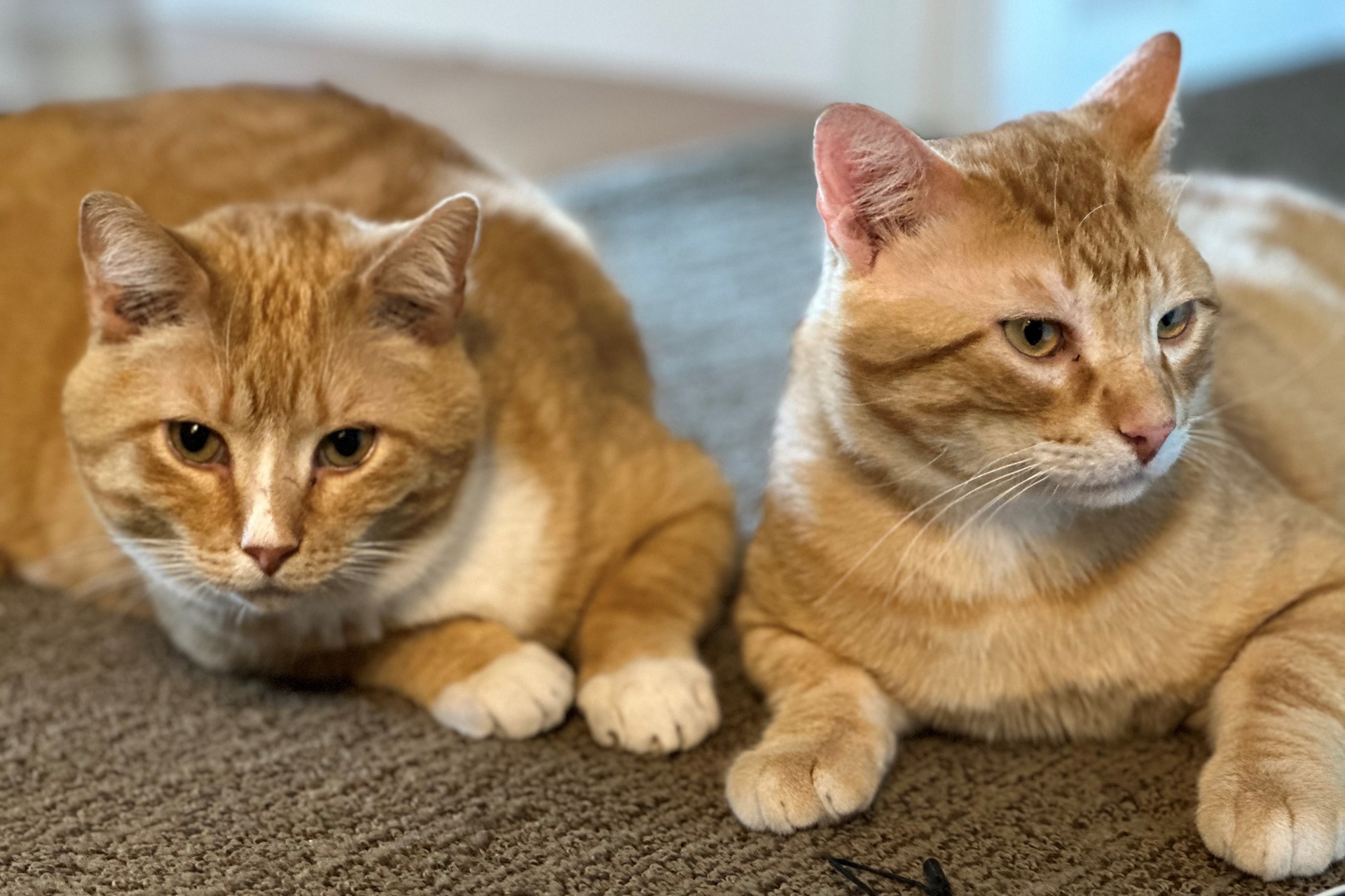
For so many cats, a shelter environment doesn’t allow their true personalities to shine. That’s why our goal is always to place our cats in adopter or foster homes.
“It made me so happy that I was a part of helping [Garfield] to bring out the love that I always knew that he had,” our volunteer socializer Vicky said. “They are now in a loving home and get to love and be loved. Every day that I go to Cat Care Society, I get to help another little kitty cat and am filled with gratitude to be able to do that.”
We thank each and every person who’s helped any of our shelter cats. Together, we’re making a world of difference in the lives of cats in need.
Have you adopted from CCS in the past? We’d love to hear how it’s going! Send us your adoption success stories (and photos!) to be featured in our #adoptionupdate series on social media or on our website.
Feel compelled by our work and want to help more cats in need find loving homes? Please send us a financial gift to provide life-saving medical care and adoption services to cats like Garfield and Big red. Donations can be made online HERE (and all funds received from Nov. 1 to Dec. 5, 2023, count for our Colorado Gives Day fundraising goal, with extra opportunities for matching incentive funds. We appreciate your support!
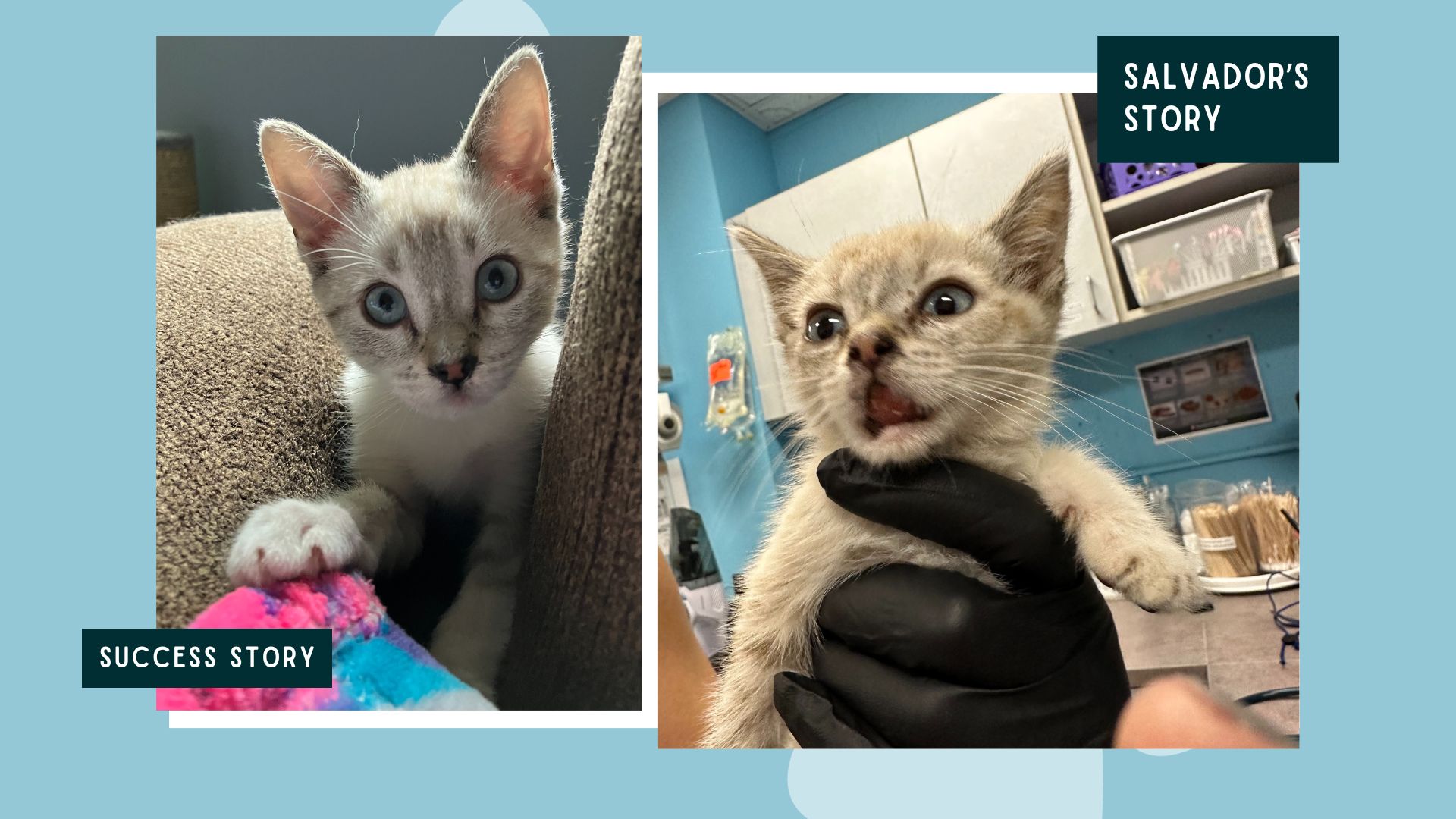
As a cat shelter that specializes in providing care and finding homes for special needs cats, we often come across unique medical cases. It’s rare for one of these cats to be so young and tiny, though.
Thus was the case when we heard about Salvador this summer. A small Siamese kitten less than 1 pound and a couple months old, Salvador had already experienced major trauma. One of our shelter partners, RezDawg Rescue, who specializes in rescuing unwanted animals in high-risk situations brought him to us, along with significant and urgent medical needs. We don’t know exactly what happened, but it was obvious that his mouth had been affected. His jaw was barely hanging on to his face.
Salvador was a stray found near a reservation in New Mexico at a flea market by a local citizen who had taken his dogs for a walk in the area. Thankfully, this good Samaritan brought him to someone that could help.
We rushed Salvador to our medical team, who confirmed that his lower lip was traumatically separated from the jaw, but there was no evidence of a fracture. Our lead veterinarian, Dr. Cecily Palamara, DVM, guessed that the injuries were due to a predator attack. “His injury is not uncommon in cats, and is often caused by a dog or other animal bite, sometimes when the victim is peeking through a fence,” she said.
Two days later, Salvador’s lip was repaired by Dr. Palamara, his jaw was reconstructed and multiple teeth were removed due to bone exposure. Like the little fighter he is, he did well under anesthesia.

Next up was a foster home for recovery with one of our volunteers. The day after arriving there, he got straight to work purring and making biscuits and was back to eating like a champ. His subsequent checkups showed the repair was holding with no signs of infection or swelling — a best-case scenario!
In the meantime, Salvador’s foster volunteer caregiver called him a “total angel.” Despite all his early trauma, Salvador maintained the best spirit. He was inquisitive, sought attention and couldn’t get enough love. He looked rough at first, but that never stopped him from playing with toys or snuggling with his people or other cats. His foster recalled that the surgical recovery cone was too big, so she used a hair scrunchie. He wanted to be close to people and became an expert at snuggling into necks and licking faces. The other in the home cat took to him immediately, following him around and joining in the cuddles.
When Salvador finally reached 2 pounds, it was time to come back to the Cat Care Society shelter to get neutered and ready for adoption. His foster remembers crying while dropping him off. Despite how much she loved him, she couldn’t keep the sweet little boy, but shared how rewarding it was to help.
Salvador’s neuter surgery went off without a hitch, and this little lovebug found a home very quickly.

Holly came to us looking for a young, extroverted cat to be a partner for her current 1-year-old cat who had recently lost his other feline friend. We had just the right kitten for her! Upon her first shelter visit, she fell in love with Salvador, and likewise, he chose her, crawling right into her shoulder and offering his signature purrs.
Holly brought him home to the rest of her family in early September of this year. They found out right away how much he likes playing with toys. She took introductions slowly, but once Salvador met resident cat Pickles, it didn’t take them long to become fast friends. They now regularly play together, groom each other and follow each other around like shadows.

Holly now calls him Dali (like the Spanish painter) and says he’s gotten bigger and has filled out, with zero jaw issues. He is great with her family and other visitors; playful, vocal and just as cuddly as ever. He is easygoing, loves to explore and climb, and receive pets in a chosen human’s lap. He’s smart, too, and knows how to pull toys out of his basket when he’s ready for playtime.
“I like his extroverted personality,” Holly said. “He’s connected to all of us, and was a really good fit. Both Pickles and Dali are thriving and blossoming. Dali gave Pickles a new life.”
Cats like Salvador remind us how much both our foster volunteer and veterinary teams are needed to repair innocent injuries and return a perfect little cat back to health so it has a second chance at life. We need your help to continue our mission of helping all cats on their journeys to finding loving homes. Will you send a financial gift to provide life-saving medical care for cats and kittens just like Salvador?
From the bottom of our hearts and on behalf of the cats, thank you!
With gratitude,
EC Michaels
Executive Director
Cat Care Society
P.S. Cat Care Society receives no government funding and relies 100% on donations from people like you. Donations can be made online, mailed to 5787 West 6th Avenue, Lakewood, CO 80214, or dropped off in person at the shelter.

What a summer it was for us here at the shelter. From a very active kitten season to several unexpected surprises and multiple significant and successful events, there were definitely no dull days.
Summer is often the busiest time of year for shelters across the country. Kitten season, aka feline breeding season, typically occurs between late March and October. We see many kittens and momma cats in need during these months, and our incredible fosters take care of the little ones until they are 2 pounds, at which point they can be spayed or neutered and ready for adoption. From April 1 to September 24, 2023, CCS took in 342 kittens. Of those, 258 were adopted and many are still growing in their foster homes!
In August, we hosted a waived-adoption-fee event in honor of Clear the Shelters month, and were overwhelmed at the positive response from our community! That day we adopted out the most cats ever in a single day for our shelter: 31 cats went into loving homes. We also received incredible support from our partner organizations and individuals that ensured the day went off without a hitch. We can’t thank you enough.
We know that there were some concerns over the decision to offer “free” adoptions, and we appreciate the concern for our cats’ well-being. The decision to offer this was made after much discussion and consideration. Please know that we always do our due diligence. All adopters must fill out an application and be approved before bringing any cat home. We want to make sure all our cats end up in loving and committed homes, and we’ll never compromise these values. There have even been multiple studies done by respected animal welfare groups that have found that waived adoption fees do not affect animals’ outcomes in any negative way.
Throughout the month of August in total, we had a total of 132cats come into our care, and we successfully adopted out 141cats. In September, we helped 120 cats — 79 kittens and 41 adults, 13 of which were seniors — find new homes. As we reflect on the prior fiscal year, we also know that we cared for about 400 more cats than the year before. We are so excited to be expanding our ability to help more cats than ever, thanks to your support.
Speaking of stats, I also want to call out a national database called Shelter Animals Count. This platform brings together 6,936 animal welfare organizations to share credible and accessible data to positively impact our animals and communities. Participating in this allows CCS to offer data transparency and greater understanding of cat’s needs across the mountain region. With this knowledge, we can deepen our impact. I encourage you to browse their data to evaluate trends and know that we are supporting these positive outcomes.
I also want everyone to know that my door and phone lines are always open. If anyone has questions or would like any clarification on our statistics, policies or our animals, I would be more than happy to discuss it with you; just reach out!
Over and over again, I am beyond impressed with the dedication our employees, volunteers and donors demonstrate. Every single time we ask for something, someone delivers. I am humbled and so grateful for every one of you who shows up when we need it most. From the bottom of our hearts, thank you.

EC Michaels
Executive Director
Cat Care Society
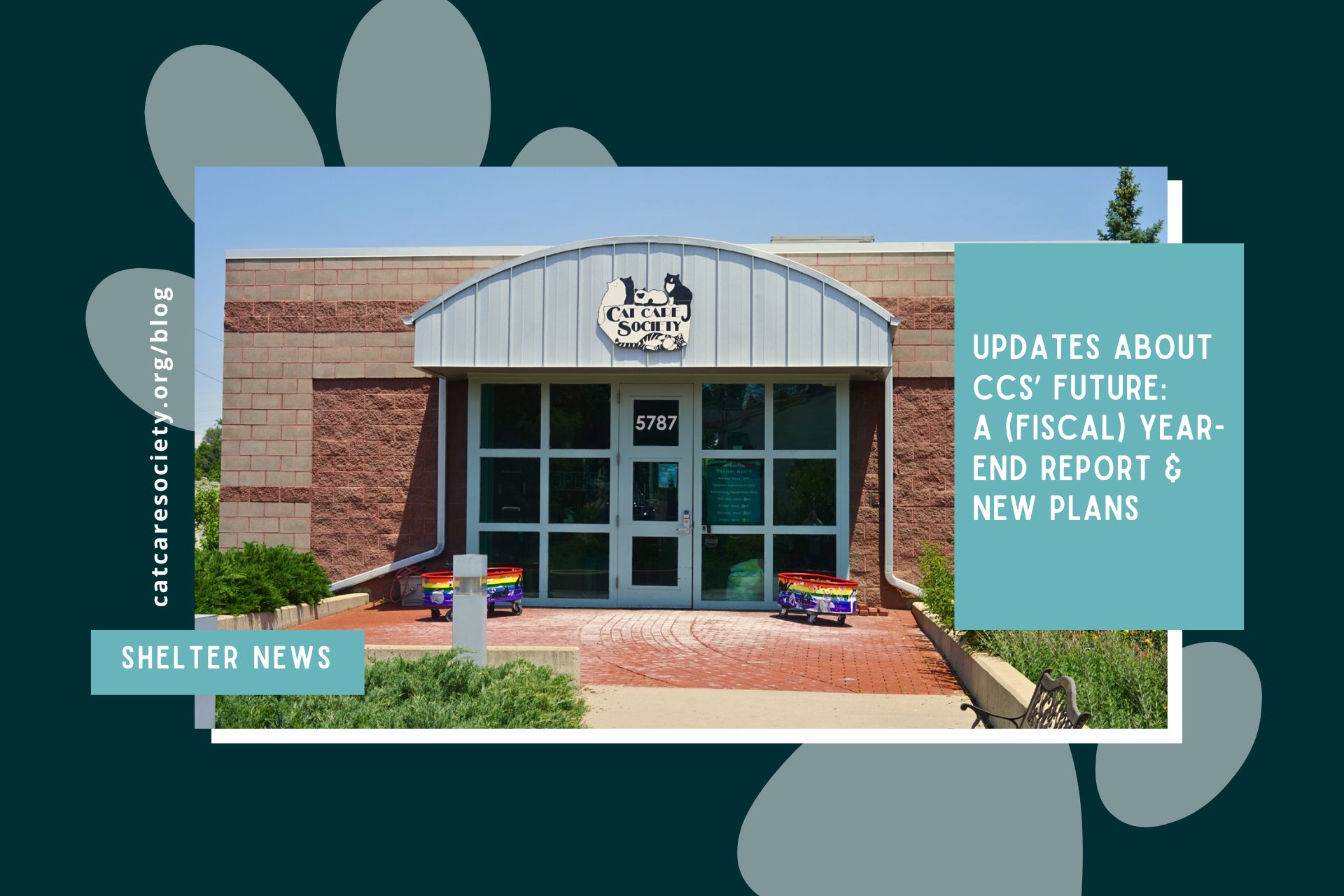
Hello friends of Cat Care Society! As I reach one full year of service with this incredible organization, I can’t help but beam with pride for everything we have achieved together and are still working to accomplish. And, I’ve got some great updates to share with you all.
CCS has so much rich history, and as we continue to drive ourselves forward, it was time to think big-picture as we go into the next era. So, to celebrate our past and expand on our offerings, we engaged in setting forth a new strategic plan. This ambitious plan helps us refine our identity and keep up with what’s needed in the animal welfare field and in our own community.
It started last February with a situational analysis of where we were, where we want to be and how to get there. We partnered with a company called Mission Spark, who conducted interviews with key staff and board members and guided a community survey that many of you reading this may have received. We were thrilled to see so many of you respond and offer your input — in fact, we had a higher-than-average response rate, which is a testament to the passion and dedication you all have. Thank you! We also took into consideration state and national trends, animal-related legislation and other peer organizations to make sure our services fit what our community needed.
The results of this work showed that we already had great dedication to the organization, strong core operations and a solid reputation among those who know us. What we discovered validated where we need to improve, which is in the areas of staffing, systems and structure, visibility and our facility.
After further analysis and a retreat with our board of directors in June, we began building a new visionary plan that focused on our guiding principles and perfectly reflected who we want to be and how we can best help the cats in our care.
What we’ve developed together sets forth a new comprehensive and cohesive identity, which embraces the building blocks that will propel us into a successful future. This plan went into effect at the start of our fiscal year on July 1, 2023, and we’ve already started the work to implement these new priorities.
But that’s not all. If you visit us online, you will see an entirely redesigned website with fresh content and new features to make it even easier to find the information you need. You may have also noticed a slight change to our logo, which features a cat with one eye and another one with one leg to reflect our values of caring for every cat, regardless of his or her condition.
Over the past year, we have also welcomed a few new members to our board of directors, who have already offered invaluable insight and experience to our leadership. Returning for another year as chair of the board is Mark Colsman, who has led this dedicated group of volunteers through a time of change as well as opportunity. We are so appreciative of all our board members have done to guide our organization forward.
I am also happy to share statistics from our most recent fiscal year, which ran from July 1, 2022 through June 30, 2023:
As you can see, more cats than ever need our help, and we’re doing all we can to step up to the plate. There is so much to look forward to as an organization and a community, and I just know that our years ahead look as bright as ever.
Rest assured that even with our new identity, there will be no changes to our existing programming. We are as dedicated as ever to serving cats and the people who love them!
Cat Care Society’s new strategic plan and identity couldn’t have come together without you, our loyal adopters, donors, volunteers, staff and community members. I am so grateful for everyone’s support and participation in helping us provide life-saving treatment and adoption services for the cats of Colorado.
Thank you.

EC Michaels
Executive Director
Cat Care Society
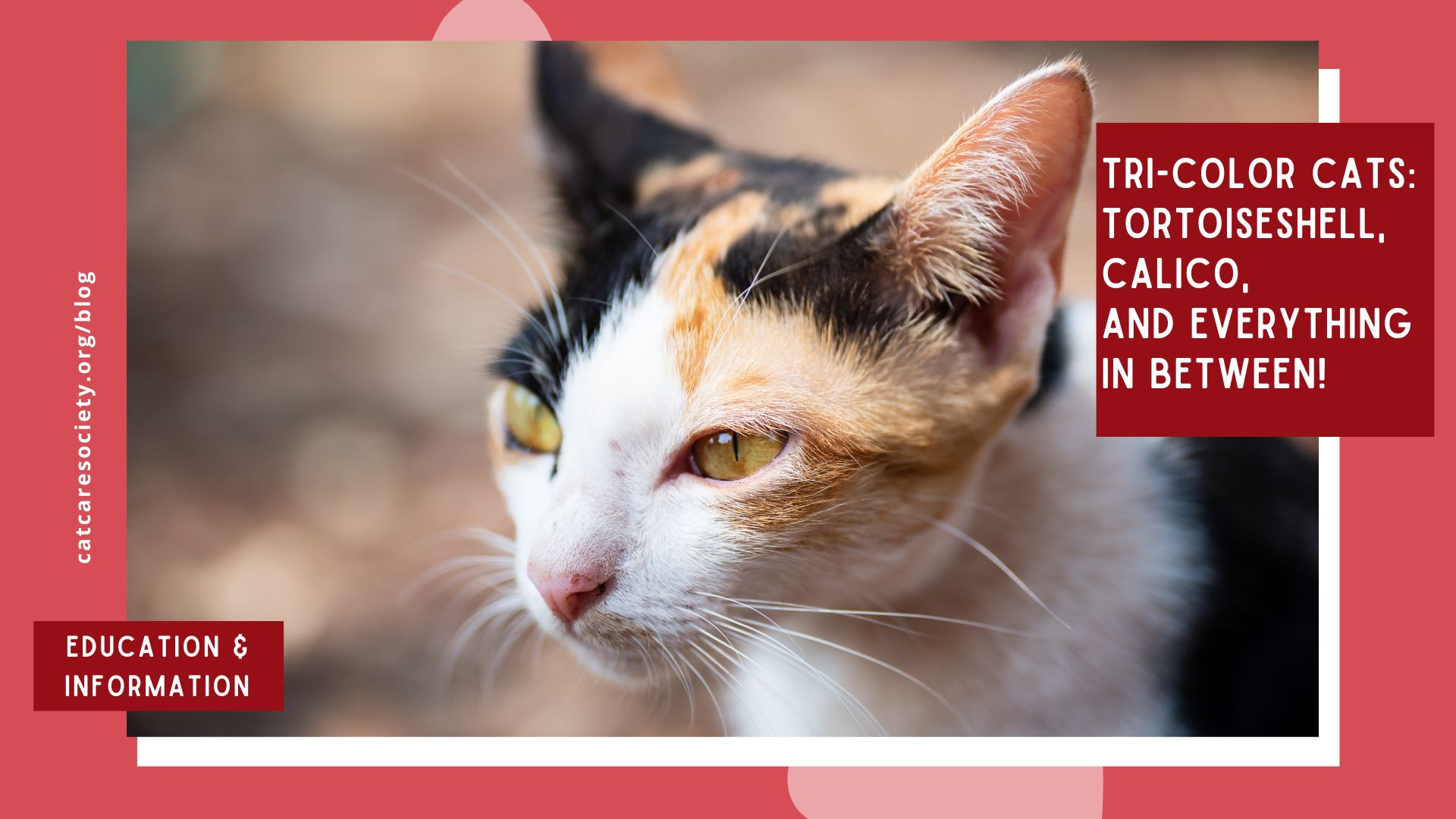
With Halloween approaching, it’s the perfect time to spotlight a particular type of cat—and no, we’re not talking about black cats! Instead, we’re focusing on tri-color cats, whose coats feature a mix of black, orange, and white in varying patterns and ratios. While “tri-color” and “calico” are often used interchangeably, calico cats have a distinct coat pattern. Tortoiseshell cats are also considered tri-color, even though they usually lack white and have their own unique pattern. It’s important to remember that “calico” and “tortoiseshell” refer to coat patterns, not breeds. These color combinations are the result of genetics and can appear in any breed, though they are more commonly found in breeds like American Shorthair, British Shorthair, Japanese Bobtail, Maine Coon, and Persian.
There are also diluted and tabby variations of tortoiseshell and calico cats—so many colorful kitties to love! In the rest of this article, we’ll explore the different markings and patterns that define each type of tri-color coat. By the end, you’ll be able to recognize the unique beauty of every tri-color cat you encounter.
Tri-color cats are almost always female, with approximately one in 3,000 being male. This is because two X chromosomes are needed to have a distinctive tri-color coat. Typically, if a cat has an XX pair, she will be female. Male cats have an XY chromosome pair, so they’re not tri-color unless they have at least one extra chromosome (XXY). Unfortunately, these males often suffer from Klinefelter’s Syndrome, a condition that can negatively affect their health and longevity.
Calico cat coats feature patches of solid orange, black, and white. The white color is a result of a genetic condition called piebalding, which occurs in a range of other domestic and farm animals. In a diluted calico, the colors are more muted to cream, gray, and white, due to a gene inherited from one of the parents that diminishes color intensity.
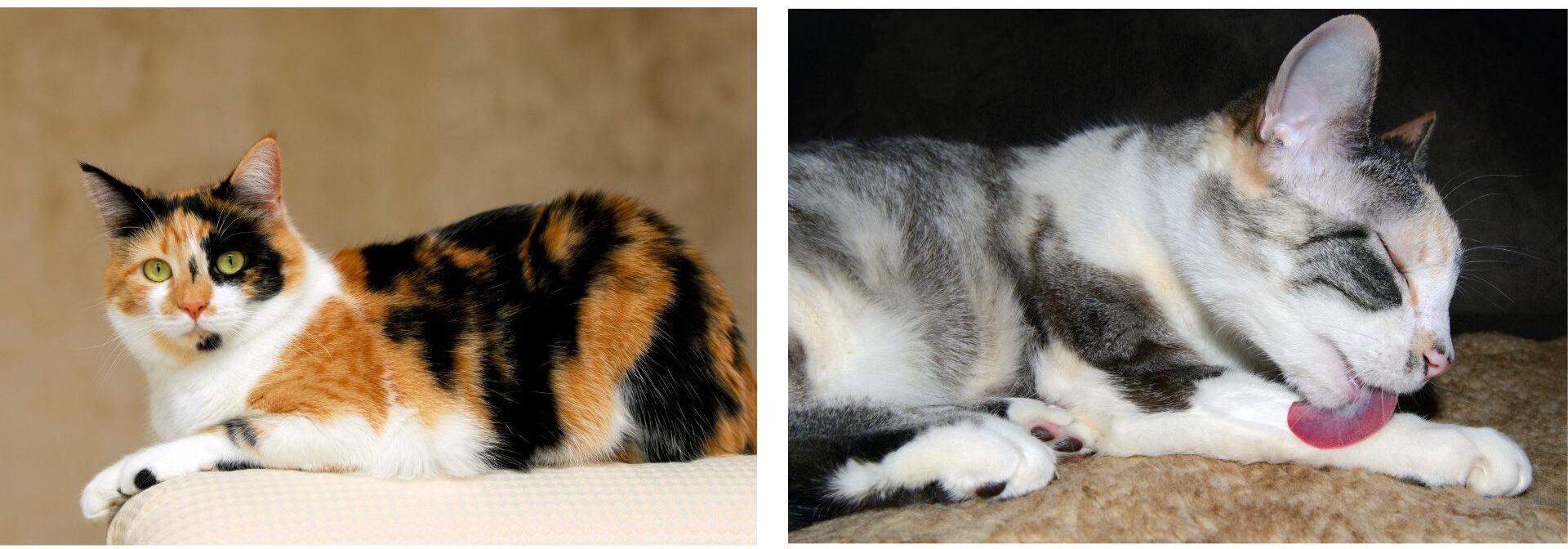
“Tabico” is a term for cats that have a combination of tabby and calico markings. These cats have large patches of orange and black on a white background, with tabby stripes overlaying some of the black and orange areas. When tabby stripes cover the forehead, they form the distinctive “tabby M.” A diluted tabico’s coat features cream, gray, and white fur.
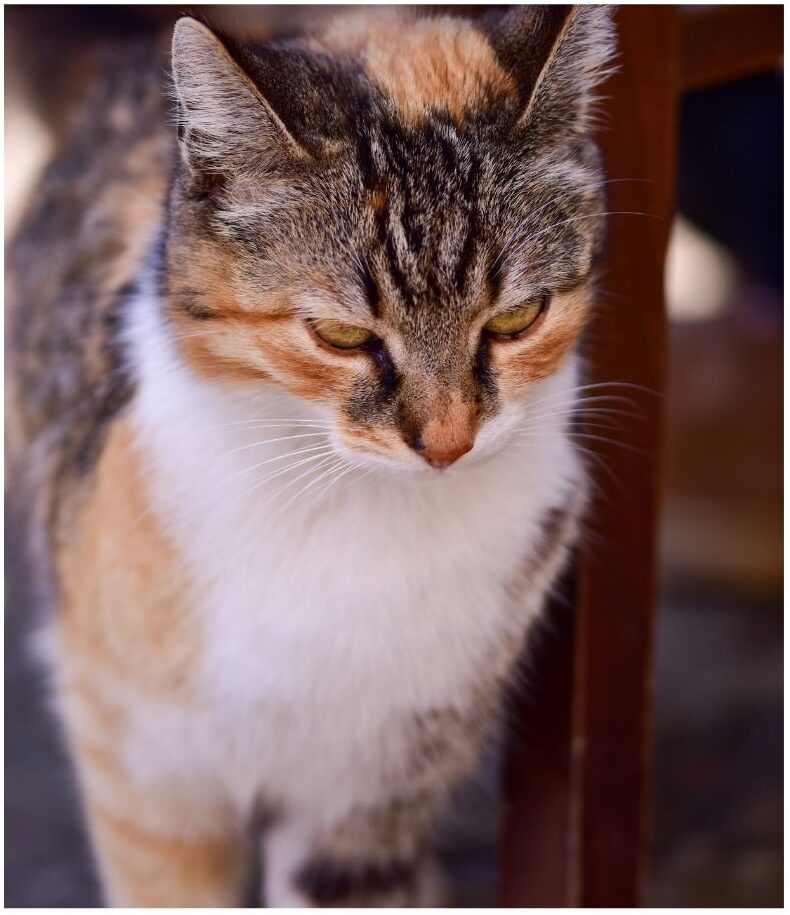
Tortoiseshell, or “tortie,” cats have brindle patterns (irregular stripes or streaks) of orange and black with little to no white. A diluted tortie has gray and cream colors and is a result of both parents carrying a recessive gene that impacts the intensity of the colors.
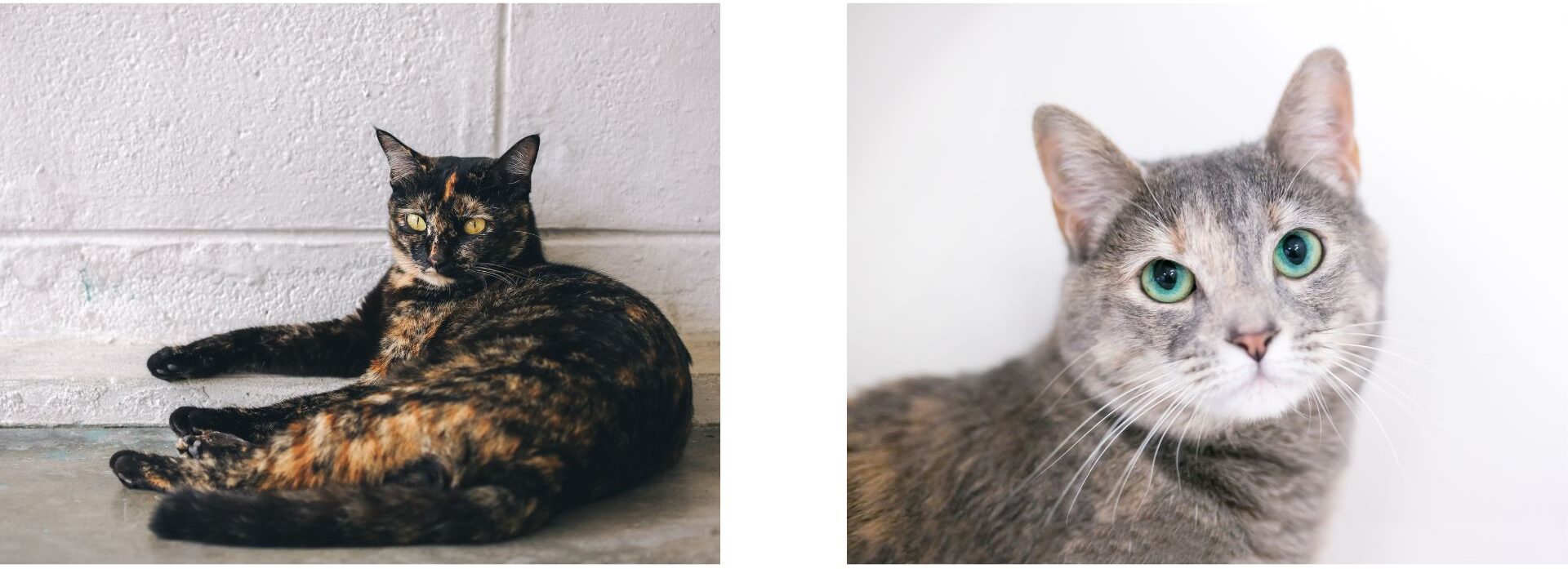
A torbie cat exhibits both the multi-colored brindle pattern of a tortoiseshell cat and the characteristic stripes or spots of a tabby. Like the tabico, if there are tabby stripes on the cat’s forehead, they will display the “tabby M.” Diluted torbies usually have a cream, gray and white coat.
A “tortico” is a combination of classic tortie and calico markings, featuring large patches of orange and black brindling on a white background. A diluted tortico is relatively rare, and will be gray and cream, and white.

As you can see, there are many variations of tri-color cats but you can still count yourself lucky if you run into one! In many cultures tri-color cats are connected with good luck and good fortune, and in the U.S., they are sometimes called “money cats.”
People who have tri-color cats often report that they’re equally sweet and sassy and tortoiseshell cat owners often refer to their feisty side as having “tortitude.” However, since tri-color cats aren’t a breed, research hasn’t been able to confirm that this extra feistiness is a distinct trait related to their coat pattern. That said, if you haven’t taken our “Whats Your Cat Purrsonality” quiz on our Just Fur Fun page, now’s your chance! Discover which cat breed or color pattern best represents you—maybe even find out if you have a bit of tortitude!”
About the Author: Beth Dokolasa is a volunteer for Cat Care Society and serves on the Board of Directors. She is an instructional developer for Natural Grocers and lives in Indian Hills, Colo., with her husband, daughter, and two cats, Techno and Digit.

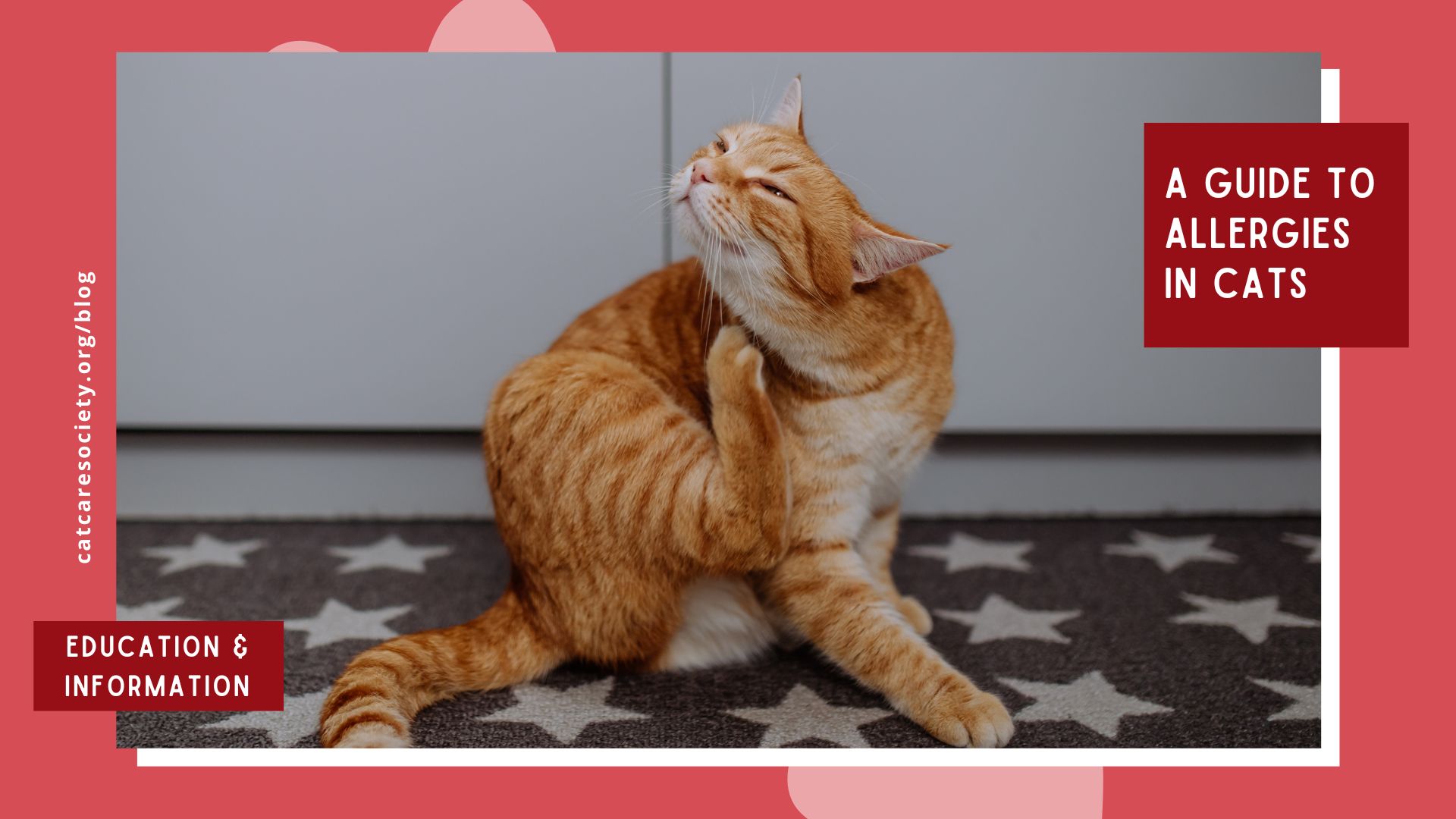
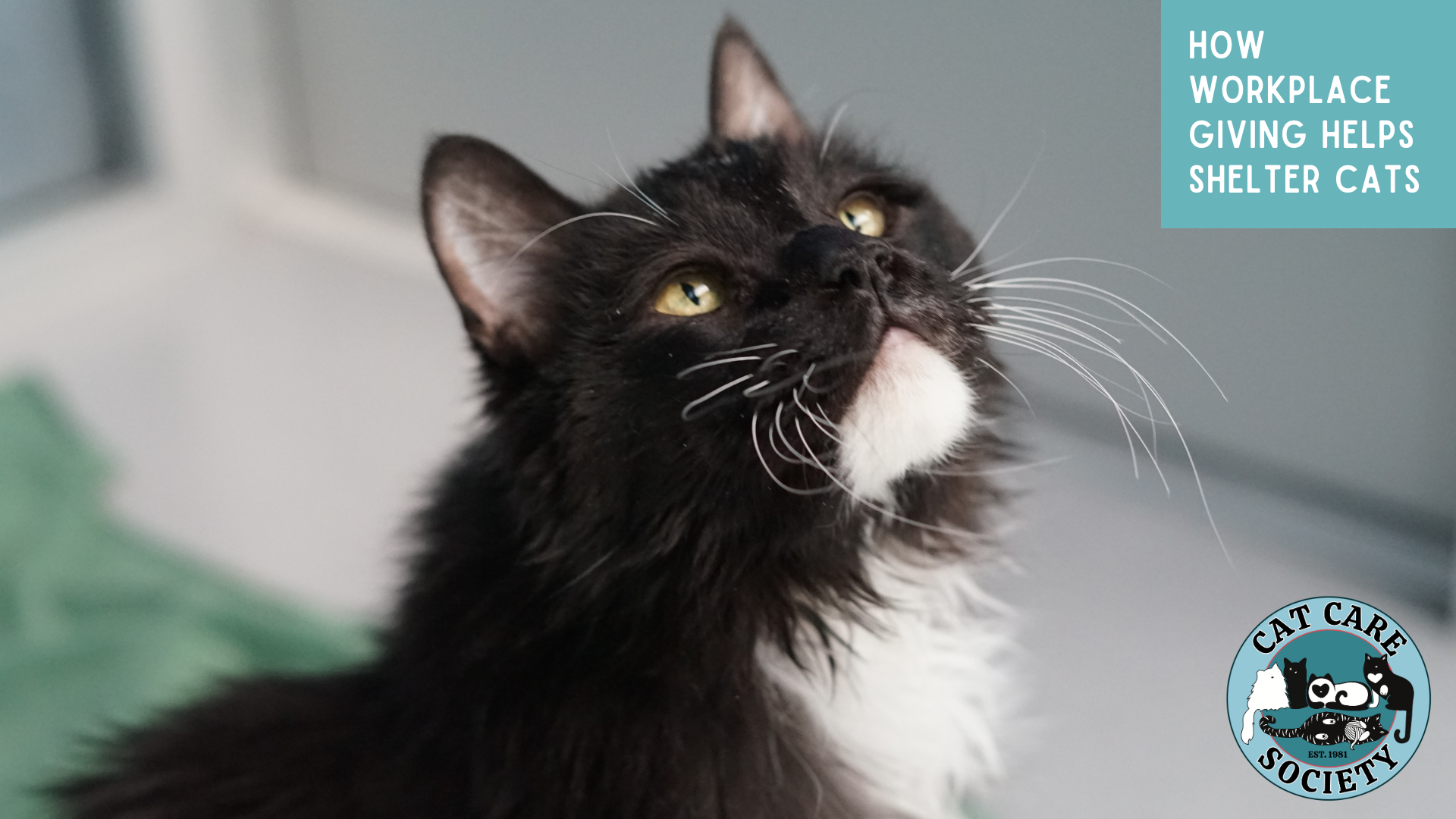


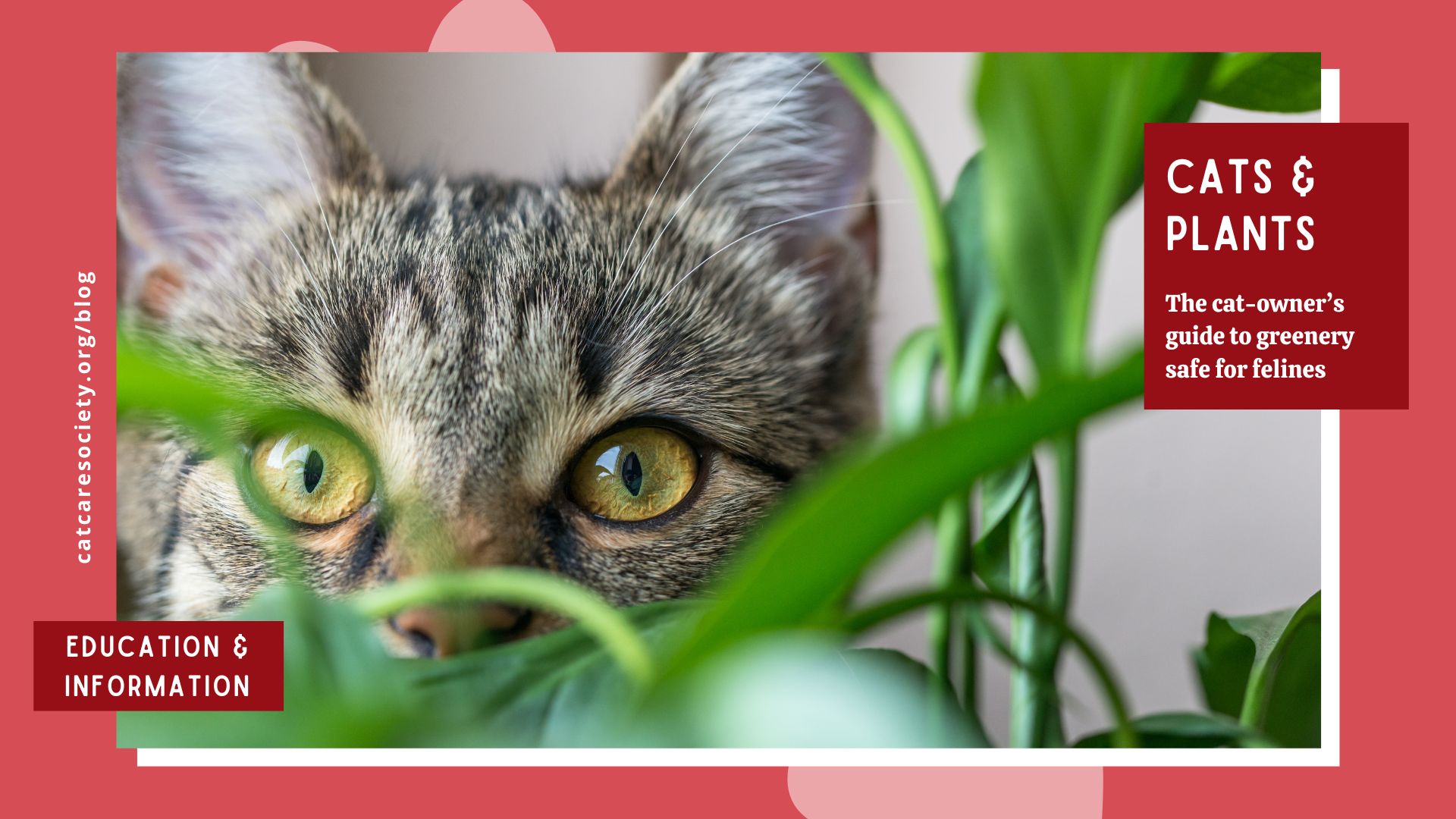

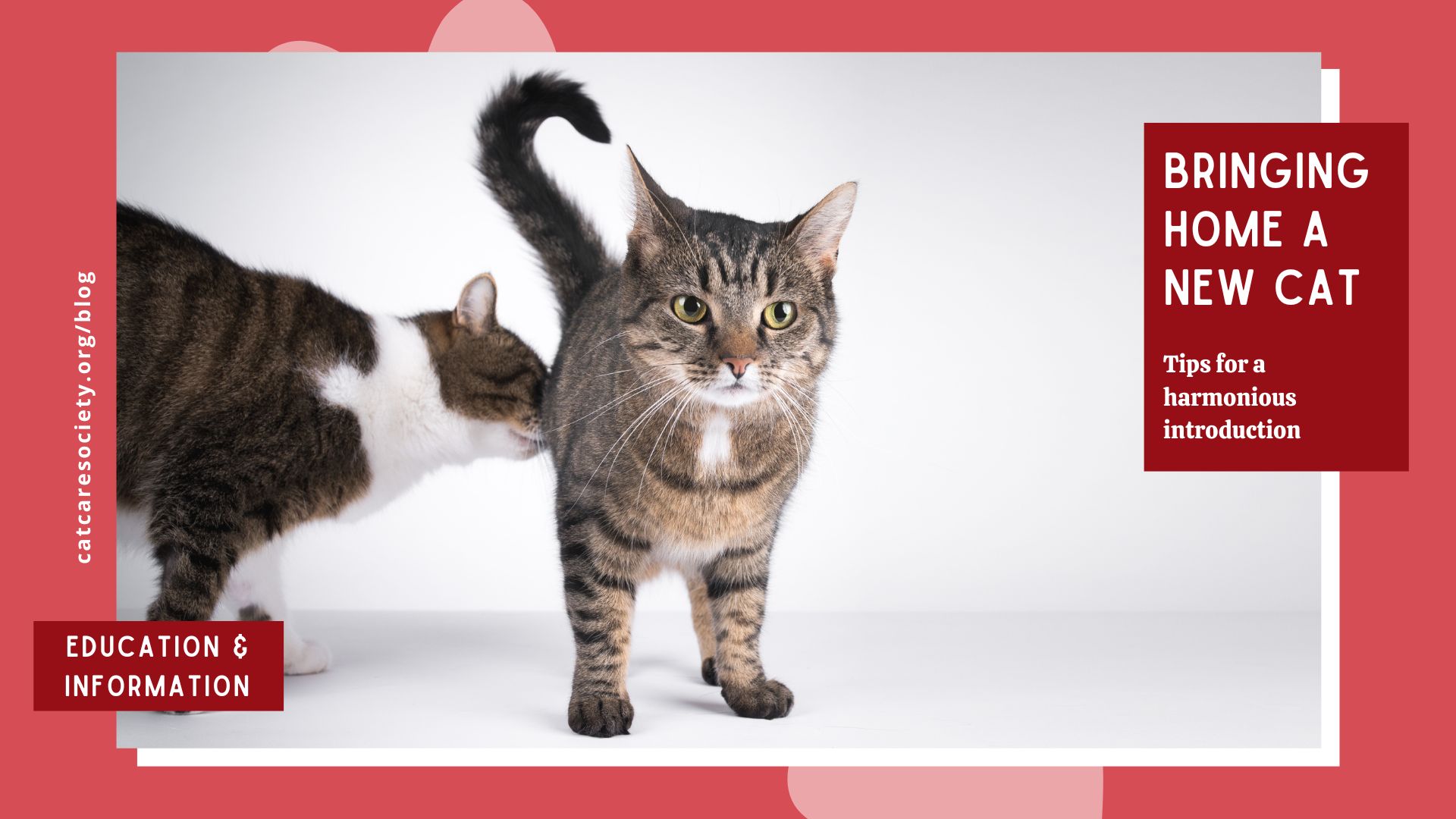

Copyright © 2024 Cat Care Society. All Rights Reserved. | Privacy Policy
The Cat Care Society is a non-profit 501(c)(3) organization. Our tax identification number is 84-0869447.